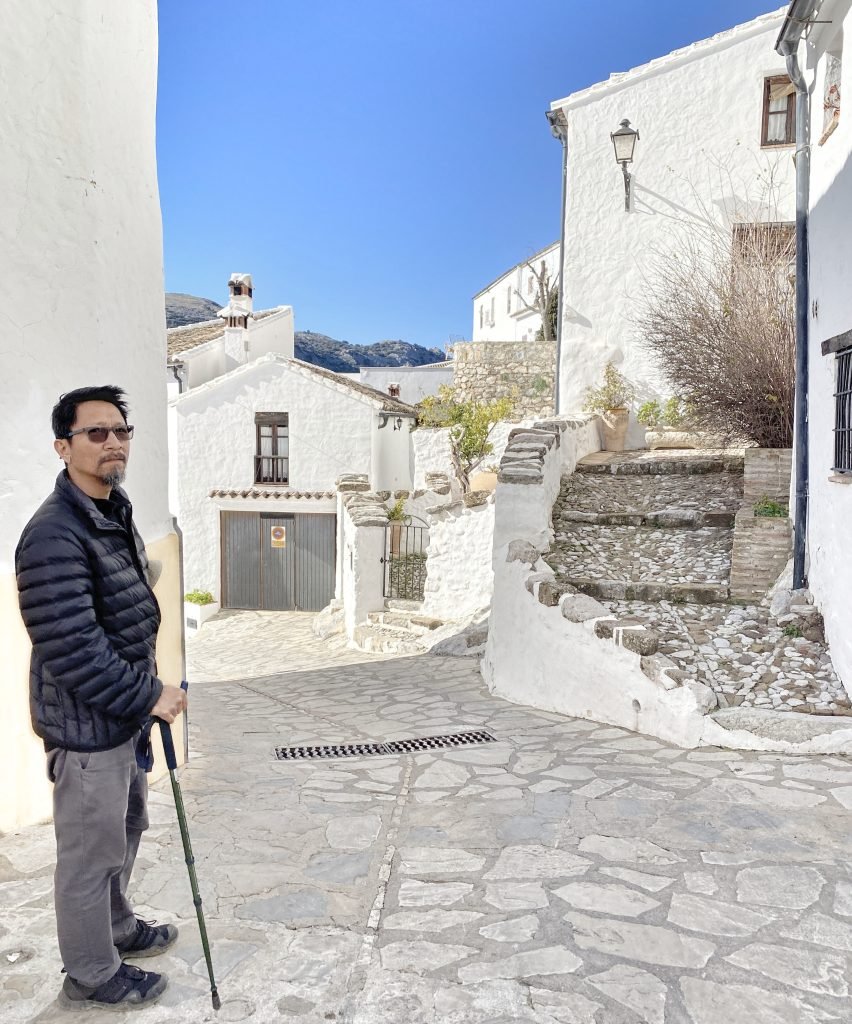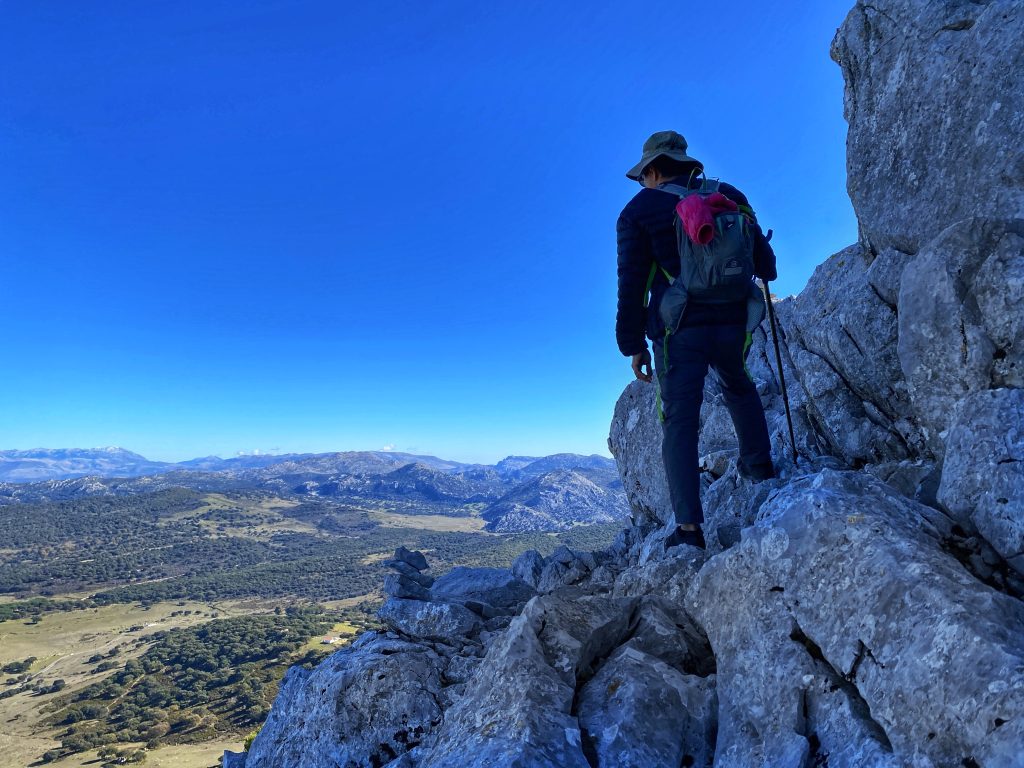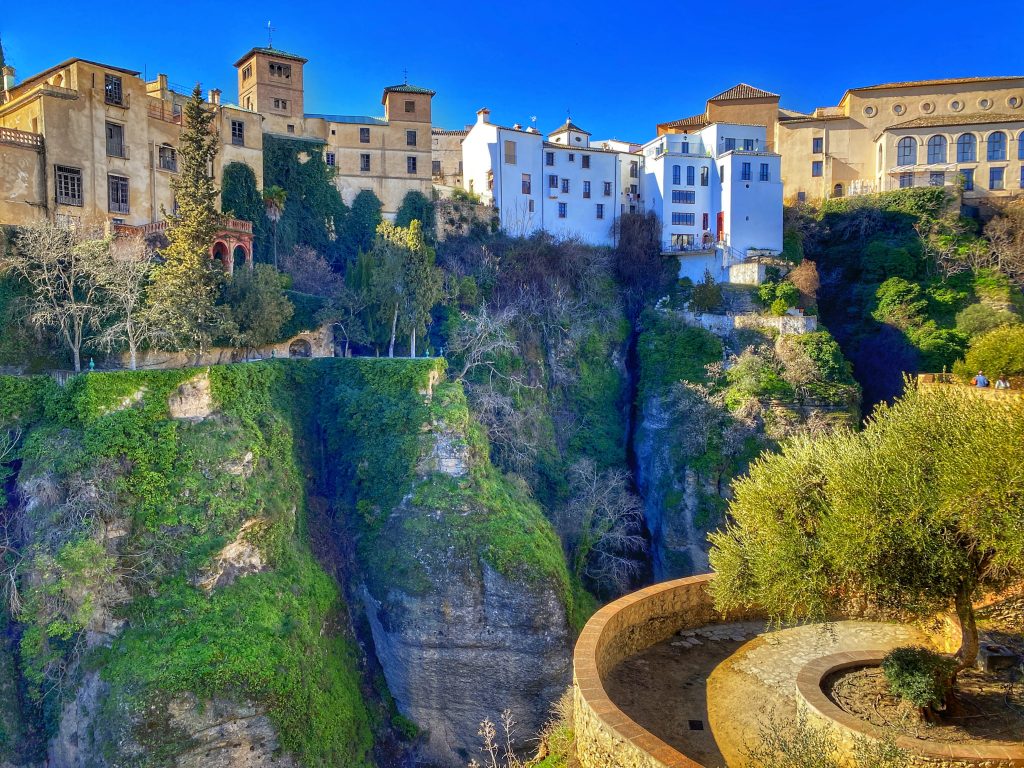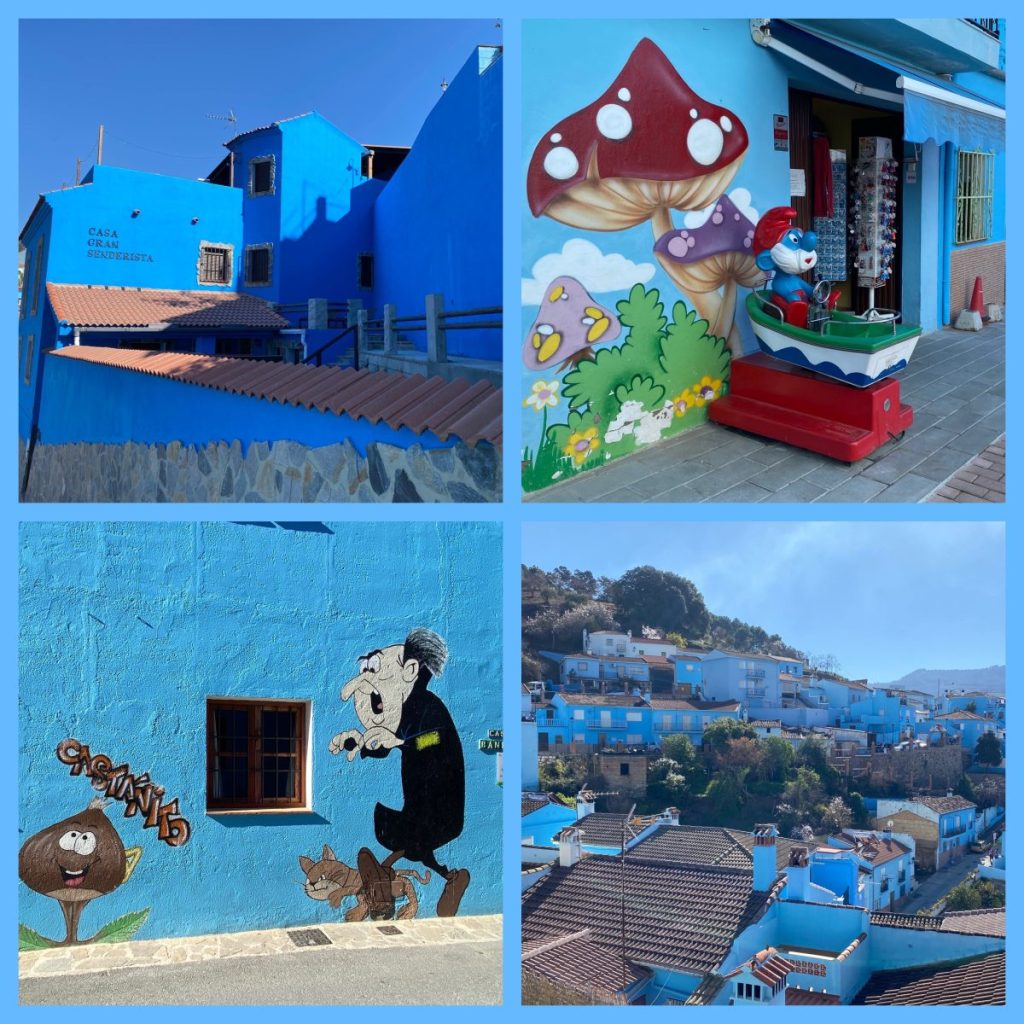The jagged limestone mountains of Andalucia hold a number of surprises for those new to the area. Narrow winding roads snake through the valleys and squeeze through villages on the steep hillsides. Towns and villages painted white appear sometimes perched on the peak of a mountain, other times they are nestled in a valley. Some hide in the crevice of a mountain clinging to the rocky inclines. They look like secrets held tightly by the limestone that appear only at certain angles as we traverse the range.

White Towns
Walking up an impossibly steep and narrow cobbled alley between painted white stone walls, we heard a noise behind us. It was a car. The side mirrors nearly brushed the walls on both sides of the street. As the car approached the intersection the driver expertly pulled in her side mirror as she squeezed around a narrow right turn. After clearing the cornerstones she popped the mirror back out. The movement was as smooth as one absently brushing a crumb off a sleeve in the midst of a conversation.
On another street, we stepped into a doorway to avoid being crushed by an oncoming car. It is modern life seamlessly living on ancient roads. The symbiosis of old and new creates a feeling of stability. Wars have been waged and rulers have changed, all the while life continues on in the villages.
There are over 50 white towns (pueblos blancos) in the mountains of Andalucia. Each is a little different, many are still dominated by the castles that protected them 2,000 or more years ago. Many cling to the rocky mountainsides. Some are ensconced in holes dug into the rock, and although modernized, they still create a fascination for the imagination.

Living under a rock – Setenil de las Bodegas
In a place that sees temperatures that rise to the high 90s F (high 30s C) in the summer living in the rock cliffside is an excellent way to keep a home or business cool and comfortable. In the winter the mountain provides insulation to keep the home warm. For centuries the carved rocks of Setenil de las Bodegas have been homes.

The true age of the town is unknown but is believed to have been a settlement since the time of the Roman invasion in the 1st Century AD. Continual occupation since that time has erased artifacts of the past.
Imagine leaning back against the wall in your bedroom, feeling stone conduct its coolness through your skin. As the coolness removes the heat from the day, can it take with it some of the worries? Maybe it has taken on the cares of lives for centuries from those who lived out their years within these walls. Time no longer remains an impassible gap unconnected to our current world.
A few homes displayed signs offering tours for a small fee. The ceilings and walls were stone, all with the tell-tale sign of a chisel. Extra space was chiseled out for a full-sized refrigerator to back up against the wall. I wondered if that was a more modern expansion.

Setenil de las Bodegas is a town with about 3,000 inhabitants. Massive rocks hang over storefronts on one street, and on the next, the rock provides a roof for homes that will never need to have shingles replaced. The cobbled paths between them lead up to the castle resting on the highest point.
Hiking above Grazalema

Grazalema is one of the white towns held like a secret in a ravine. We could see Grazalema from the distant ridge of the Roman Theater in Acinipo, but a day later, when we were just on the other side of the valley, it was hidden from our view.
Just above Grazalema, a path leads out of town and up the ridge line providing stunning views of the valleys on all sides. Hoar frost in delicate tiny spikes covered patches of earth still in shadows. The town below us grew smaller as our distance and elevation increased.
The trail was poorly marked and we lost it a number of times. We ended up bush-whacking through thorns and climbing over boulders to reach the trail above us – at least where maps.me (we now use the Organic Maps app) said the trail should be. It was fun but added length to our journey.
Finally reaching the trail we found tiny little yellow-painted arrows that were about the length of my middle finger. They led us to an open rock face with a narrow trail to the other side.

Bleat for Lunch
From the middle of the open rock face, we stood at least 1,500 feet above the farm in the valley below. A lone bleat reached our ears echoing off the karst landscape. It was followed by another baa, then it seemed the entire herd joined in. We looked down to see sheep, tiny cotton dots running toward feeders in a famished cacophony. There they formed parallel lines each finding a spot to devour their lunch.

“Is this trail supposed to be technical?” I asked Trin looking at the next little arrow that pointed up.
“No,” he said as I looked down over the cliff beside us.
At least limestone has many crevices providing great handles and the surface is generally grippy unlike the slippery surface often found on granite and harder stone. I clung to the rocks as we rounded the edge of the mountain.
Griffon vultures circled beside us, high above the landscape. The wingspan of these large raptors extends eight feet. They continued upward riding the thermals and reaching even greater heights. I wonder how often they catch these rising heat columns and soar just out of the joy of it. Do they feel joy?

On the other side of the mountain, we perched on the rock ledge to eat our lunch.
Zahara de la Sierra

As we drove down the windy road through the Grazalema National Park one mountain stood out from the rest. At its crest, a castle spire points to the sky as though proclaiming, “King of the mountain!” White homes cling to the side of the mountain below the cliffs of the castle striking a pose of defiant existence.
Torre Alhaquime

When we arrived at the base of Torre Alhaquime we found a parking spot at the bottom and decided to walk the road to the top. It was so steep I thought my toes would touch my chin with each step forward. Homes were built into the hillside rooflines of one almost level with the doorstep of the home just behind it.
The top of the hill is leveled off into a courtyard with viewpoints on all sides of the surrounding valleys.
Ronda

Ronda was our home base while exploring the white-painted towns. Each night on our way home we marveled at the sight of a city built to the cliff edge.
The city of Ronda is split by a 120-meter-deep (390 ft) chasm through which flows the Guadalevín River. One of the most impressive features of Ronda is the Puente Nuevo (meaning “new bridge”) that spans this chasm.
In 1735 construction of a bridge across this chasm began that would connect the two sides of the growing city of Ronda. It collapsed in 1741 killing 50 people.
This “new” bridge was completed in 1793. Did the builder not think it would last long – that “new” would apply during its entire existence? Thankfully, it is still standing now 288 years later.
A smaller bridge spans the other lower side of this chasm that separates the two sides of the city.

Paths follow the edge of the cliff on which the city sits and another path descends down into the valley for beautiful views of the bridge and the cascading Guadalevin River.
Why Paint them White?
It is believed that the traditional white of the villages started in the 14th century when whitewash, or cal, was created from slacked lime. Not only does the cal keep homes cooler in the summer but it was thought to be hygienic. Later it was found that the slacked lime does help kill the bacteria that causes cholera. ¹ We wandered through village after village with white-washed walls.
“What makes them all want to maintain white? I mean it’s cool and together makes the area a wonderful attraction, but what if one of them said, ‘Let’s be different to increase intrigue and tourism?'” I asked Trin.
“Wait till tomorrow,” he said.
Out of the blue

What would happen if Sony Estonia approached one of these white Andalucian towns and offered to paint it something other than white to celebrate the premiere of a new movie? Would the entire town allow their tradition to change? Knowing how hard it is to get an organization to adopt change – even if the change is a huge improvement in ease of work – I wondered if a whole town would agree to such a drastic change.
In 2011 this happened. Juzcar was asked by Sony to help them promote the release of the Smurfs movie. The entire town agreed to paint all their buildings blue. The original agreement with Sony included a restoration to white within six months.
Prior to 2011, the town had 9,000 tourists a year. Within six months of painting the town blue, they had 95,000 visitors.
The town held a meeting and agreed to keep the color blue. Now, 12 years later it is still blue. Sometimes when making a change we have to take a leap, but other times we have the option to just try it and then go back if we don’t like it. We might find out how good change can be and not want to go back.

(okay, I confess: I edited the photo to add the 4. Photo taken in Montejaque, Spain)

Very very interesting. Can you imagine the beauty that these people had every day, looking out across the valley from the side of the mountain!!!!!!
Yes, it was so beautiful looking out over those views. We stayed just a block from the tall bridge near the edge of the cliff for about a week. We loved it.
Love these photos, you’ve intrigued me. I knew nothing about this area before.
Thank you! Honestly, I didn’t know a whole lot about the area before exploring it either. My next post will include some history of this area that I also found intriguing.
Just beautiful photos Bonnie
Thank you Judith!